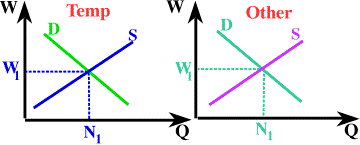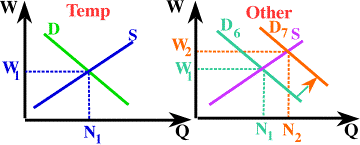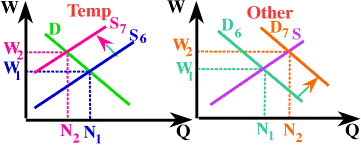

This isn't a difficult market analysis at all but it's probably useful to take a look at how one might graphically explain what has occurred in the market for temporary holiday retail workers.

In order to properly understand what has happened we need to keep in mind that workers who take jobs as temporary retail clerks during the holidays may prefer full time jobs if they are available, especially if the pay is also better. Suppose the market for workers with the necessary skills looked like the graph above in the Winter of 1996. There are two markets shown here, the market for temporary retail workers during the Winter holiday shopping season, marked Temp and other job opportunities for people with similar skills and abilities marked Other. To simplify matters we suppose that wages are identical in the two markets during 1996. (In fact they might differ somewhat due to working conditions, benefits, and long term employment, but the point is that the wages were similar relative to job desirability).
The fact is that the US economy has been relatively strong this year and unemployment is relatively low in many parts of the country. As a result demand for workers at this skill level has increase in other industries during the year. The result of this is shown in the graph below.

Notice that the 1997 demand curve, D7, for workers in the Other market increased causing both wages and numbers hired to rise relative to 1996.
Because we are supposing that these two markets hire workers with similar capabilities this means that many of those who might have otherwise taken temporary holiday jobs may instead take jobs in the Other industries. This leads to a shift back in supply in the Temp market relative to 1996 as shown below, causing wages to rise for temporary workers.

Depending on how high wages rise or don't in the Temp market there could be further supply shifts in either or both markets. Likewise there could be demand shifts in either or both markets depending on sales (remember that demand for a factor of production is a derived demand, derived from the demand for the final product).
The point is though that a change in demand in one labor market can lead to a change in wages and in the supply of labor in markets which employs similar workers. This explains why faculty at Med Schools are always paid far better than Economics Professors, who are in turn paid better than Dance Professors (often the lowest paid faculty in schools that have dance programs). Much of the difference is a function of alternative market opportunities.
The other point is that if you're looking for temporary work, this might be the season.
Copyright © 1995-2003 OnLineTexts.com, Inc. - All Rights Reserved